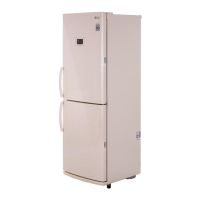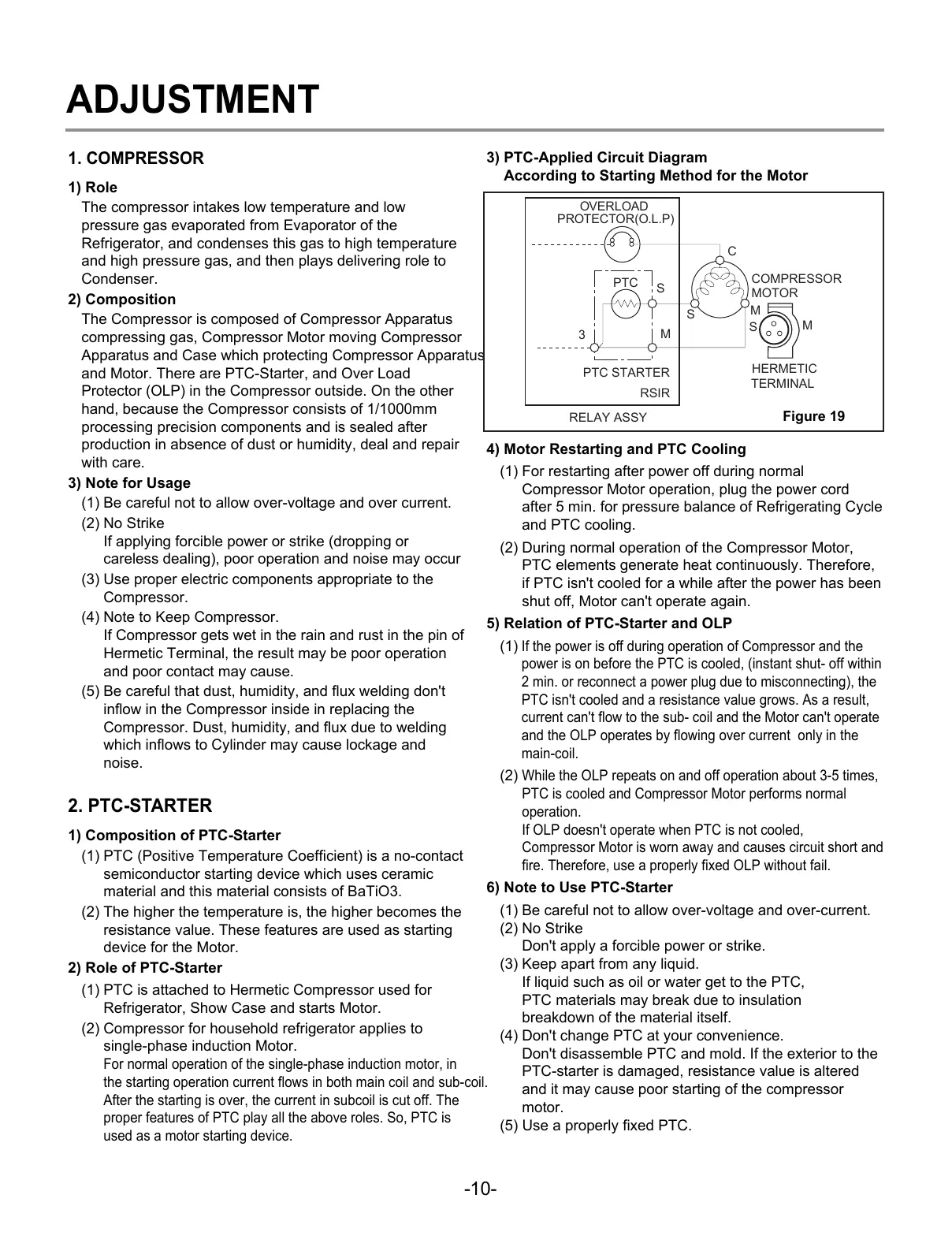ADJUSTMENT
-10-
1. COMPRESSOR
1) Role
The compressor intakes low temperature and low
pressure gas evaporated from Evaporator of the
Refrigerator, and condenses this gas to high temperature
and high pressure gas, and then plays delivering role to
Condenser.
2) Composition
The Compressor is composed of Compressor Apparatus
compressing gas, Compressor Motor moving Compressor
Apparatus and Case which protecting Compressor Apparatus
and Motor. There are PTC-Starter, and Over Load
Protector (OLP) in the Compressor outside. On the other
hand, because the Compressor consists of 1/1000mm
processing precision components and is sealed after
production in absence of dust or humidity, deal and repair
with care.
3) Note for Usage
(1) Be careful not to allow over-voltage and over current.
(2) No Strike
If applying forcible power or strike (dropping or
careless dealing), poor operation and noise may occur
(3) Use proper electric components appropriate to the
Compressor.
(4) Note to Keep Compressor.
If Compressor gets wet in the rain and rust in the pin of
Hermetic Terminal, the result may be poor operation
and poor contact may cause.
(5) Be careful that dust, humidity, and flux welding don't
inflow in the Compressor inside in replacing the
Compressor. Dust, humidity, and flux due to welding
which inflows to Cylinder may cause lockage and
noise.
2. PTC-STARTER
1) Composition of PTC-Starter
(1) PTC (Positive Temperature Coefficient) is a no-contact
semiconductor starting device which uses ceramic
material and this material consists of BaTiO3.
(2) The higher the temperature is, the higher becomes the
resistance value. These features are used as starting
device for the Motor.
2) Role of PTC-Starter
(1) PTC is attached to Hermetic Compressor used for
Refrigerator, Show Case and starts Motor.
(2) Compressor for household refrigerator applies to
single-phase induction Motor.
For normal operation of the single-phase induction motor, in
the starting operation current flows in both main coil and sub-coil.
After the starting is over, the current in subcoil is cut off. The
proper features of PTC play all the above roles. So, PTC is
used as a motor starting device.
3) PTC-Applied Circuit Diagram
According to Starting Method for the Motor
4) Motor Restarting and PTC Cooling
(1) For restarting after power off during normal
Compressor Motor operation, plug the power cord
after 5 min. for pressure balance of Refrigerating Cycle
and PTC cooling.
(2) During normal operation of the Compressor Motor,
PTC elements generate heat continuously. Therefore,
if PTC isn't cooled for a while after the power has been
shut off, Motor can't operate again.
5) Relation of PTC-Starter and OLP
(1)
If the power is off during operation of Compressor and the
power is on before the PTC is cooled, (instant shut- off within
2 min. or reconnect a power plug due to misconnecting), the
PTC isn't cooled and a resistance value grows. As a result,
current can't flow to the sub- coil and the Motor can't operate
and the OLP operates by flowing over current only in the
main-coil.
(2)
While the OLP repeats on and off operation about 3-5 times,
PTC is cooled and Compressor Motor performs normal
operation.
If OLP doesn't operate when PTC is not cooled,
Compressor Motor is worn away and causes circuit short and
fire. Therefore, use a properly fixed OLP without fail.
6) Note to Use PTC-Starter
(1) Be careful not to allow over-voltage and over-current.
(2) No Strike
Don't apply a forcible power or strike.
(3) Keep apart from any liquid.
If liquid such as oil or water get to the PTC,
PTC materials may break due to insulation
breakdown of the material itself.
(4) Don't change PTC at your convenience.
Don't disassemble PTC and mold. If the exterior to the
PTC-starter is damaged, resistance value is altered
and it may cause poor starting of the compressor
motor.
(5) Use a properly fixed PTC.

